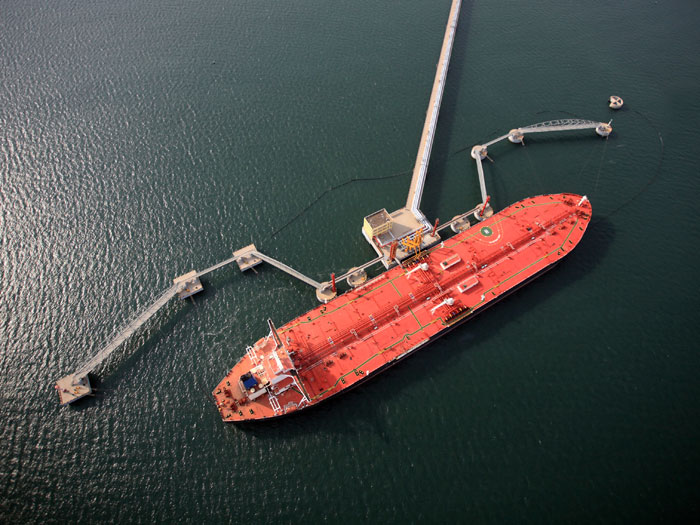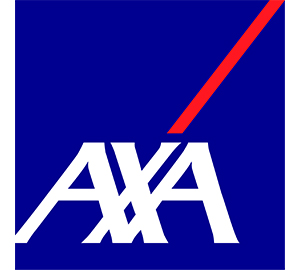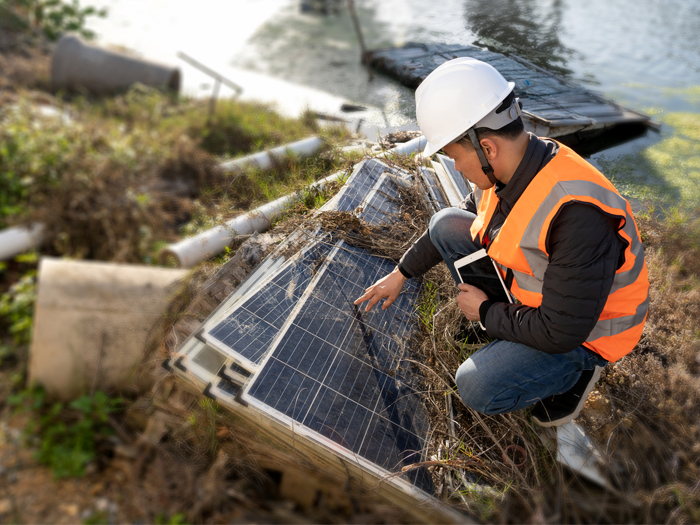Risk Scenario
Tainted Goods
Disclaimer: The events depicted in this scenario are fictitious. Any similarity to any corporation or person, living or dead, is merely coincidental.
Big Plans
Nothing beats working with the best. That’s what Jerry Oliver, a senior vice president with Manhattan-based Lupex, told himself as he left the morning meeting.

In that meeting, executives with Lupex, an energy trading firm, voted to buy two million barrels of crude and store it offshore. A precipitous decline in oil prices was the motivation.
All the firm had to do was keep the oil safe and sound until the prices rose again, which they inevitably would. Major domestic drillers were already laying off staff and cutting production. These latest low oil prices were just another bend in the cycle.
Oliver’s marching orders from that morning’s meeting were clear. Working with other members of the Lupex team, it was Oliver’s responsibility to find the right vessel and a safe place to moor it.
The strategy was to keep the oil safe by avoiding CAT-exposed locations and hold it long enough for the firm to cover its storage costs and still make a handsome profit when the price rose.
“Let’s get this done,” Oliver said to himself before walking into his office to get on a phone call with a colleague in Texas.

After consulting with his colleague, Oliver decided to use the Miller Line, a company based in the energy hub of Houston. The Miller Line was an owner of Very Large Crude Carriers — or VLCCs.
One of the company’s ships, the Mariana, had the capacity that Lupex needed and was available. Adding to the attractiveness of the Mariana was that she was already in Southern California, not far from the tank farm in El Segundo where the oil was stored.
The Lupex team decided to moor the Mariana off of Long Beach, once she’d taken on the Lupex crude.
“We don’t want to store it in the Gulf, or anywhere near Florida,” Oliver told his team, pointing to the hurricane hazards in those locations.
“Long Beach has also got the security infrastructure we like,” Oliver said.
Lupex procured the oil at $50 per barrel the following morning, making its value at purchase $100 million. To wrap up the deal, Oliver and his associates took care of some final details, among them, getting insurance in place.
Loading at the tank farm went off without a hitch and the Mariana was moored off of Long Beach. Within days, it looked like oil prices had bottomed.
Weeks later, after a particularly sharp, sustained rise in the price of oil, Lupex executives gave the “sell” order.
With oil at $80 per barrel at the time of the sale, it looked like the company’s strategy was playing out as well as could be hoped. The Mariana made her way to Houston, to offload the oil for the buyer.
At 2 p.m. on the afternoon the oil was offloaded in Houston, Jerry Oliver got a call from Antony Ellis, his associate in Houston.
“We’ve got a problem, a very serious problem,” Ellis said.
“What is it?” Oliver asked.
“The oil’s contaminated,” Ellis replied.
“What?” Oliver said.
“It’s true,” Ellis said. “Apparently, the ship was carrying gasoline before it picked up the crude load and wasn’t cleaned properly.”
“The gasoline additives that remained in the tanker contaminated the crude, lowering its grade and market value,” Ellis further explained.
‘Somebody’s got to tell the executive committee. I’ll do it,” Oliver said.
Then he hung up the phone.
Game Change
On their follow-up call, Ellis and Oliver began to put the pieces of a disturbing picture together.

“So we can re-blend it?’ Oliver said.
“In essence, yes,” Ellis said.
“It’s a lower product grade, and far less valuable, and then there’s our mixing costs and other related expenses,” he said.
“If we’re very, very lucky and we get this done in no more than two days’ time. We might be able to get $42 per barrel for this lower grade product. I don’t see how we can hold it any longer,” Ellis said.
“Nobody up here has any patience for anything more than that,” Oliver said.
Oliver wasn’t sharing with Ellis the exact tone and temperature of the conversation that he’d had with senior management when he brought them the bad news to begin with. He’d spare his colleague that extra pain.
Working as quickly as they had ever worked, with neither of them sleeping more than four hours over a 48-hour period, Oliver and Ellis arranged for the re-blending of the ill-fated oil from the Mariana.
When all was said and done, Lupex got $41 per barrel for the re-blended product. A down day in the markets worked against them, but as traders, they knew that timing was everything. They were already down millions. They could not afford to wait a day longer. Two days after the sale of the re-blended product, Oliver was speaking with a senior executive, conducting a post-mortem on what became an instant legend at Lupex, “The Long Beach Loss.”
“What do our insurance carriers have to say about this?” the executive asked.
“Ummm, I haven’t talked to them yet,” Oliver said. He was back in his office and on the phone with Lupex’s broker within a minute, his ears still hot from the tongue-lashing his superior had given him.
The broker, Danny Parker, a young gun with a multinational firm, listened to the details of the loss as relayed by Oliver.
“Well, I’ve got a question for starters,” Parker said.
“What?” Oliver said.
“Why didn’t you contact me earlier?” Parker asked.
A List of Ills
Falling oil prices in 2014 were something that got everybody’s attention. Everyone of driving age could see it as gasoline prices at the pump plummeted.

Lupex executives couldn’t be blamed if they were practically obsessed with the rate at which oil prices were going down. After all, this was what they did; it was their bread and butter.
They had the capital and the connections to do very well on what looked like a historic trading opportunity. A two-year average oil price of more than $110 per barrel was becoming a dream-like memory as oil prices fell to below $80 per barrel, then $70 per barrel and on and on down.
Lupex executives were bright and well-schooled. They knew the history of the energy sector. They’d worked extremely hard, done very well over the years and felt they had earned this moment.
As with anyone, it was what they didn’t know that dealt them such a painful blow.
It fell to Danny Parker, the energy insurance broker, and his colleague, Lee Ann Farmer, a cargo specialist, to give Lupex the most painful messages of all.
“Jerry and Antony … let me ask you something. When you arranged to lease the Mariana from the Miller Line, did you ask them about what the Mariana previously held, and whether the vessel posed a contamination risk?”
“That’s on me,” Antony Ellis said. “The short answer is no. You have to understand — we weren’t the only traders on the planet that had their eye on this opportunity. VLCC rates were showing a lot of volatility of their own in late 2014,” he said.
“A lot of people were after this opportunity,” Oliver said.
“We understand …” Danny Parker managed to get out before Antony Ellis interrupted him.
“We’re talking about storage rates of tens of thousands of dollars per day, and in one week alone in November, we saw a 20 percent increase in those leasing rates. There was a lot to consider here,” Ellis said.
“I’m sure there was,” Lee Ann Farmer said.
“I know you had a lot to consider,” she continued. “But you should have thought about a cargo policy. After all, once that product leaves land and goes into a ship, you’re in a completely different ballgame from a coverage perspective.”
“Okay, but how exactly?” Jerry Oliver began.
“Just hold on a second,” Danny Parker said.
“That contamination issue you had? I bet you I could have covered that for you,” Lee Ann said.
Oliver felt nausea roil his stomach.
“You’re kidding me,” he said. “All of it?”
“I’m pretty sure the carrier would have you retain some of it,” Lee Ann said. “But in our world, these days, there’s a lot of capacity out there.”
“I never knew,” Antony Ellis said.
“Sorry. But now you know,” Danny Parker said.
Lupex would live to seek other opportunities in coming months and years, but its insurance coverage lapse in the Long Beach loss cost the company an opportunity that might have been once in a lifetime.
![]()
Risk & Insurance® partnered with XL Group to produce this scenario. Below are XL Group’s recommendations on how to prevent the losses presented in the scenario. These “Lessons Learned” are not the editorial opinion of Risk & Insurance®.
1. Consider an Ocean Cargo Policy: For a relatively low cost compared to the value of goods, an ocean cargo policy can be structured to cover perils of the seas (i.e. sinking, fire, collision, explosion, heavy weather), General Average, Theft, Fire, Acts of War, Shortage, Leakage and contamination. In the “Tainted Goods” risk scenario, if Lupex had purchased an appropriately structured ocean cargo policy, the company would have been covered for the loss due to contamination.
2. Choose Appropriate Limits: When evaluating an ocean cargo policy, risk managers need to ensure that the amount of insurance will be sufficient to cover the goods at the maximum foreseeable financial interest. This is especially important in dealing with commodities, like oil, where there’s a chance of financial fluctuations.
3. Valuation of Goods: For an effective ocean cargo policy, it should be structured to allow the buyer to be indemnified for the highest value of goods for several different situations, including:
- The invoice value + 10% (for ancillary/related costs)
- The selling price (if sold)
- The market value on date of loss
With these different evaluations structured into the policy, this will allow for recovery of the amount paid at a minimum, or the full mark up if sold or unsold at a maximum.
4. Ensure Professional Handling of Goods: Bulk liquids and solid goods pass through a number of loading mechanisms, holding tanks/locations, pipelines, conveyor belts, loading machinery and pumps when moving from shore to vessel and vice versa upon unloading. This opens up the potential for many types of losses, including: shortages, contamination and loss in weight. In order to reduce this risk, companies should take the steps to ensure professional handling of their goods by working with tenured logistics providers.
5. Reduce Your Contamination Risks: It’s common for companies to conduct and pay for testing and approval of tanks as well as a certificate by a qualified surveyor. However, it’s important that additional samples are taken at loading and unloading to determine if, where, or when the contamination occurred. This is also recommended for barges, lighters, tank cars and port side tanks. Most of all, a company operating in this space should make sure the handling guidelines are adhered to. By following the handling guidelines, the insurance coverage will remain valid.
6. Consult with your Marine Broker & Underwriter: Marine brokers and underwriters can offer specific knowledge and experience that can be leveraged in certain classes of businesses. They can discuss best practices and provide recommendations to reduce your risk. In addition, they can provide value added services in terms of Risk Engineering, Claims, and various technical white papers, which can serve as readily available resources.
Partner Resources
XL Marine Ocean Cargo Product Sheet










